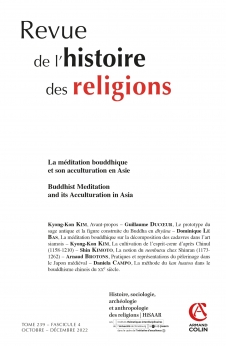
REVUE DE L'HISTOIRE DES RELIGIONS (4/2022)
Pour acheter ce numéro, contactez-nous
Recevez les numéros de l'année en cours et accédez à l'intégralité des articles en ligne.
Le moine bouddhiste Chinul demeure l’une des figures majeures dans l’histoire du bouddhisme coréen, en raison de sa synthèse conceptuelle des deux courants bouddhiques principaux à son époque, scolastique et méditatif, et de sa sotério-méthodologie plurielle, admises progressivement comme le modèle théorique et pratique à suivre au sein du saṃgha bouddhique du pays du Matin calme. Cette contribution présente les pratiques méditatives préconisées par ce maître bouddhiste, avant d’examiner leur singularité, perceptible en tant qu’acculturation pragmatique opérée dans un contexte marqué par la contradiction entre l’idéal bouddhique et la réalité ambivalente du saṃgha péninsulaire d’alors.
The Buddhist monk Chinul remains one of the major figures in the history of Korean Buddhism, because of his conceptual synthesis of the two main Buddhist currents of his time, scholastic and meditative, and his plural soterio-methodology, which were gradually accepted as the theoretical and practical model within the Buddhist saṃgha of the Land of the Morning Calm. This contribution presents the meditative practices advocated by this Buddhist master, before examining their singularity, perceptible as a pragmatic acculturation operated in a context marked by the contradiction between the Buddhist ideal and the ambivalent reality of the peninsular saṃgha of that time.

